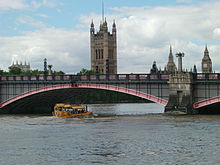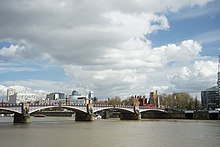Lambeth Bridge
51°29′40″N 0°07′23″W / 51.49444°N 0.12306°W
Lambeth Bridge | |
|---|---|
 | |
| Coordinates | 51°29′41″N 0°07′26″W / 51.494636°N 0.123877°W |
| Carries | Lambeth Road |
| Crosses | River Thames |
| Locale | London, England |
| Characteristics | |
| Design | Arch Bridge |
| History | |
| Opened | 19 July 1932 |
| Location | |
 | |
Lambeth Bridge is a road traffic and footbridge crossing the River Thames in an east-west direction in central London, England; the river flows north at the crossing point. Downstream, the next bridge is Westminster Bridge; upstream the next is Vauxhall Bridge.
The most conspicuous colour in the bridge's paint scheme is red, the same colour as the leather benches in the House of Lords which is at the southern end of the Palace of Westminster nearest the bridge. This is in contrast to Westminster Bridge which is predominantly green, the same colour as the benches in the House of Commons at the northern end of the Houses of Parliament.
On the east side, in Lambeth are Lambeth Palace, the Albert Embankment, St. Thomas' Hospital, and the International Maritime Organization. On the west side, in Westminster, are Thames House (the headquarters of MI5), behind which is Horseferry House (the National Probation Service headquarters), and Clelland House and Abell House (the headquarters of HM Prison Service), and the Millbank Tower and Tate Britain. The Palace of Westminster is a short walk downstream to the north through the Victoria Tower Garden.
History





The current structure, a five-span steel arch, designed by engineer Sir George Humphreys and architects Sir Reginald Blomfield and G. Topham Forrest[1], was built by Dorman Long[2] and opened on 19 July 1932 by King George V. It formerly carried four lanes of road traffic (now reduced to three lanes, one of which is a buses-only lane flowing eastbound) from a roundabout junction by the Lambeth Palace northwards to another roundabout, where the Millbank road meets Horseferry Road (the road name gives a clue to a previous crossing: a ferry operated on the site for some years).
The bridge is notable at road level for the pairs of obelisks at either end of the bridge, which are surmounted by stone pinecones. However, there is a popular urban legend that they are pineapples, as a tribute[3] to Lambeth resident John Tradescant the younger, who is said to have grown the first pineapple in Britain.[4]
The bridge was declared a Grade II listed structure in 2008, providing protection to preserve its special character from unsympathetic development.[5] The listing designation includes the parapets, lamps, obelisks and the approach walls.
The previous structure was a suspension bridge, 828 feet (252.4 m) long, designed by Peter W. Barlow. Sanctioned by an Act of Parliament in 1860, it opened as a toll bridge in 1862 but doubts about its safety, coupled with its awkwardly steep approaches deterring horse-drawn traffic, meant it soon became used almost solely as a pedestrian crossing. It ceased to be a toll bridge in 1879 when the Metropolitan Board of Works assumed responsibility for its upkeep — it was by then severely corroded.
Lambeth Bridge in popular culture
The bridge was used for the 2004 film Harry Potter and the Prisoner of Azkaban for a scene where the Knight Bus must pass between two Leyland Titans.
The bridge was seen in the BBC crime drama Waking the Dead (episode: Every Breath You Take, 2001). A body was fished out of the Thames and a body was found hanging from the side hooks.
Lambeth Bridge was the scene of the verbal exchange between Solomon Vandy (played by actor Djimon Hounsou) and the Van de Kaap corporation representative (played by actor Michael Sheen) in the 2006 film Blood Diamond.
The Lambeth Bridge roundabout was in the 1985 film National Lampoon's European Vacation as the place where the Griswald family became stuck in traffic for hours.
Lambeth Bridge was used for a One Direction music video, One Thing. Lambeth Bridge was also featured in the 1982 music video hit 'Pass the Dutchie' by Musical Youth.
References
- ^ [1] Listing description on British Listed Buildings
- ^ Where Thames Smooth Waters Glide
- ^ commemorative pineapples
- ^ Vauxhall Society:Tradescants
- ^ "London bridges get listed status". BBC News. 26 November 2008. Retrieved 26 November 2008.
External links
- Survey of London entry
- Lambeth Bridge (1862) at Structurae
- Lambeth Bridge (1932) at Structurae
- London Transport Museum Photographic Archive


